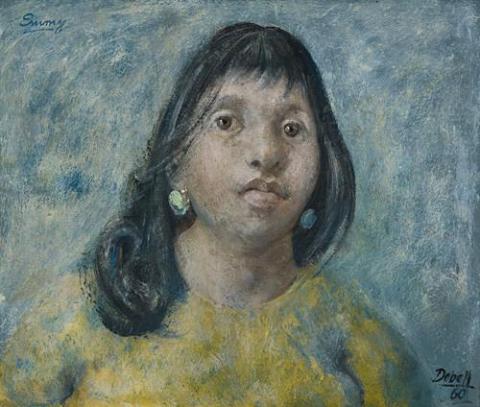EMMY, 1960
William Dobell
oil and enamel on composition board
45.0 x 53.5 cm
signed and dated lower right: Dobell / 60
titled upper left: Emmy
Mr Camille Gheysens, Sydney by 1964
Major Harold de Vahl Rubin, Queensland
Mr & Mrs Benno Schmidt, Esperance, Western Australia & New York, USA
Sotheby's, Melbourne, 28 April 1998, lot 180
Gould Galleries, Melbourne
Private Collection, Queensland
Gould Galleries, Melbourne
Private collection, Melbourne
William Dobell paintings from 1926 to 1964, Art Gallery of New South Wales, Sydney, 15 July–30 August 1964, cat. 195
On loan to Art Gallery of Western Australia 1994–95
Twentieth Century Australian Art: A Major Collectors' Exhibition, Gould Galleries, Melbourne and Sydney, 25 March – 11 June 2000, cat. 22
Modern/Traditional/Contemporary, Gould Galleries, Melbourne and Sydney, 22 February – 30 March 2003, cat. 21
Gleeson, James, William Dobell, Thames and Hudson, London, 1964, cat. 254
Although William Dobell completed very few paintings during 1960, three were portraits - Emmy, one of Helena Rubinstein titled Woman in a Salon, and Prime Minister R. G. Menzies. Always seeking to capture the personality of his sitter and what lies beyond mere appearance, Dobell presented three entirely different characters. Rubinstein, the internationally famous queen of cosmetics, is portrayed with elegance and refinement as Dobell explores her blend of diffidence and strength. Menzies' portrait speaks of power and superiority. In Emmy directness of observation reveals something of the nature of the person herself, extended through a certain generosity of form. The paintings of the two women also reveal those stylistic developments taking place in his portraiture at the time. Figures and faces have become rounder, aided by the strokes of the brush which quite consciously follow the contours. The fullness of the lips in Emmy is repeated in the cheeks, which, in turn, are echoed in the curves of her hair. This is extended into the shoulders and folds of her body, touching on generosity of character. Even the earrings add a touch of the now characteristic roundness. A strong rhythmic feeling, allied to this new delicacy of modelling, now permeates much of his work, especially in his 1960 venture into abstraction and his subject paintings.
The 1960s were richly successful years for Dobell beginning with the announcement that the portrait of his surgeon, Dr. E. G. MacMahon had won the Archibald Prize. It was Dobell's third Archibald. Commissions came from HM the Queen and the Duke of Edinburgh, and portraits for the cover of Time magazine, the first being Prime Minister Menzies. Most important was the large retrospective at the Art Gallery of New South Wales, only the second such exhibition honouring a living Australian artist. The noted Sydney collector Camille Gheysens lent fourteen paintings, Emmy being prominent among them. Gheysens had a richly diverse collection of Dobell's' work dating from the early Interior with the Artist's Mother, 1926-27 through paintings of London and Bruges, to New Guinea works. There was also a portrait of Gheysens, which had been exhibited in the same Archibald Prize as the masterpiece, Dame Mary Gilmore. In the retrospective's opening month of July 1964, James Gleeson's richly illustrated book on Dobell was published by Thames and Hudson of London. Successes continued with one of the richest art prizes in the world, the Britannica Australia Award, followed by a solo London exhibition at the Qantas Gallery. When he was knighted in 1966 he had reached the height of popularity. Given the many artists acclaimed today, it is difficult to appreciate the then singularity of Dobell's achievement.
DAVID THOMAS
